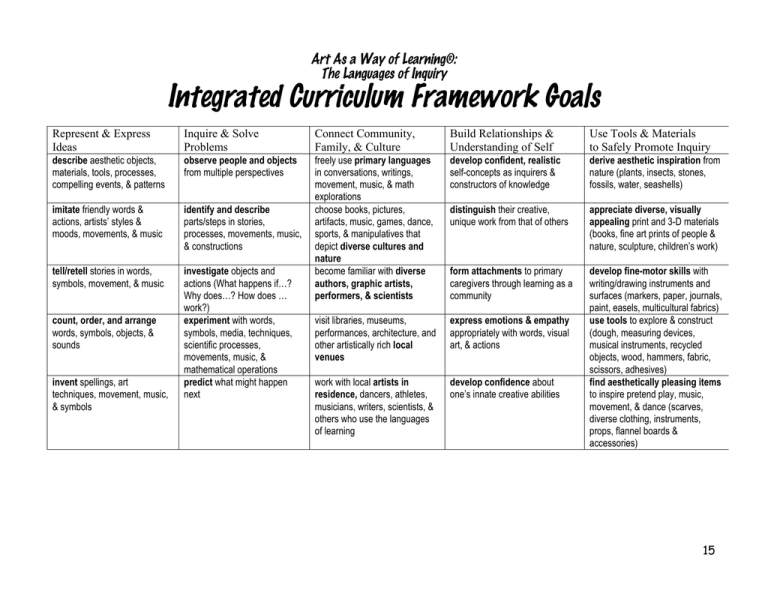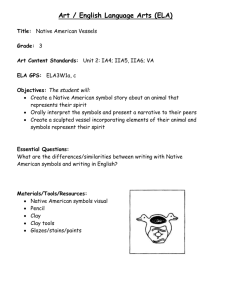Integrated Curriculum Framework Goals Art As a Way of Learning®:
advertisement

Art As a Way of Learning®: The Languages of Inquiry Integrated Curriculum Framework Goals Represent & Express Ideas Inquire & Solve Problems Connect Community, Family, & Culture Build Relationships & Understanding of Self Use Tools & Materials to Safely Promote Inquiry describe aesthetic objects, materials, tools, processes, compelling events, & patterns observe people and objects from multiple perspectives develop confident, realistic self-concepts as inquirers & constructors of knowledge derive aesthetic inspiration from nature (plants, insects, stones, fossils, water, seashells) imitate friendly words & actions, artists’ styles & moods, movements, & music identify and describe parts/steps in stories, processes, movements, music, & constructions distinguish their creative, unique work from that of others appreciate diverse, visually appealing print and 3-D materials (books, fine art prints of people & nature, sculpture, children’s work) tell/retell stories in words, symbols, movement, & music investigate objects and actions (What happens if…? Why does…? How does … work?) experiment with words, symbols, media, techniques, scientific processes, movements, music, & mathematical operations predict what might happen next freely use primary languages in conversations, writings, movement, music, & math explorations choose books, pictures, artifacts, music, games, dance, sports, & manipulatives that depict diverse cultures and nature become familiar with diverse authors, graphic artists, performers, & scientists form attachments to primary caregivers through learning as a community visit libraries, museums, performances, architecture, and other artistically rich local venues express emotions & empathy appropriately with words, visual art, & actions work with local artists in residence, dancers, athletes, musicians, writers, scientists, & others who use the languages of learning develop confidence about one’s innate creative abilities develop fine-motor skills with writing/drawing instruments and surfaces (markers, paper, journals, paint, easels, multicultural fabrics) use tools to explore & construct (dough, measuring devices, musical instruments, recycled objects, wood, hammers, fabric, scissors, adhesives) find aesthetically pleasing items to inspire pretend play, music, movement, & dance (scarves, diverse clothing, instruments, props, flannel boards & accessories) count, order, and arrange words, symbols, objects, & sounds invent spellings, art techniques, movement, music, & symbols 15 read words, symbols, their own words, others’ words, & music communicate information & data with words, symbols, movement, music, & visual devices reflect on, critique, and help to document their own work & that of others employ multiple approaches to explore literary, mathematical, & scientific symbols; movement; & music connect new knowledge to prior experiences select natural, diverse, aesthetic learning materials reflect on, critique, and help to document their own work & that of others reflect on, critique, and help to document their own work & that of others attend concerts, dramatic performances, & athletic events play and work both alone and in groups to form a group identity as a creative, healthy learning community resolve social conflicts verbally, through music, or with the other languages of learning make increasingly difficult choices & accept the logical, natural consequences experiment with structured learning materials (unit and hollow blocks, wood math manipulatives, puzzles, games) develop gross-motor skills with indoor and outdoor equipment that invites individual and group learning (play structures, riding vehicles, puppet stages) implement recordings and computer software, printers, & scanners with which to create, view other’s work, & document children’s learning 16



